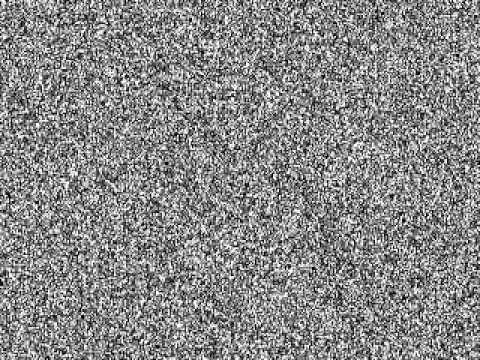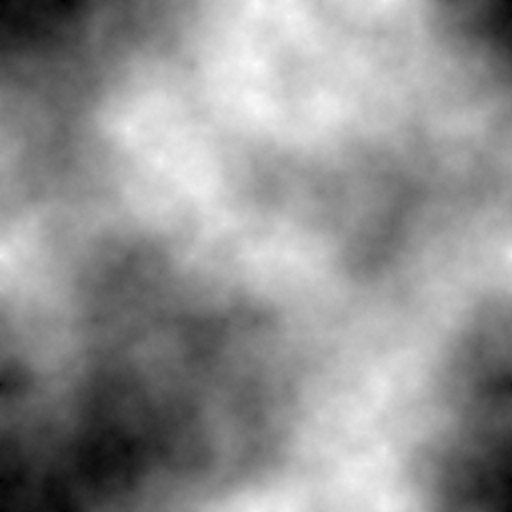
Replying to: 12Me21
12Me21
It might be faster to COPY between two arrays instead of using SHIFT/POP (though I don't know if this significantly affects the overall speed)
How would that work? Does COPY wrap around?
Root / Submissions / [.]
 But controlled random noise looks much nicer:
But controlled random noise looks much nicer:
 We're going to use the Diamond Square algorithm (a controlled random noise generator) to make the plasma effect you see in the video above.
We're going to use the Diamond Square algorithm (a controlled random noise generator) to make the plasma effect you see in the video above.
COMMON DEF NORMALIZE2D D#,SIZEX,SIZEY DIM MINV#=MIN(D#) DIM MAXV#=MAX(D#) DIM RANGE#=MAXV#-MINV# DIM X,Y FOR Y=0 TO SIZEY-1 FOR X=0 TO SIZEX-1 D#[X,Y]=(D#[X,Y]-MINV#)/RANGE# NEXT NEXT ENDThis function is included in Random's Big Dumb Library Now we can do Diamond Square. Diamond square works on a chunk system like minecraft: each chunk is 2N wide and tall and the overall array is a series of these chunks. The array that's returned is JUST a 2D array of values though; the chunks are "imaginary" and are only used in the algorithm. The parameters are: Feature Size (N), Width (Chunks across), Height (Chunks down), Seed (same seed = same noise), Decay (lower=smoother noise). The final dimensions of the returned noise array is (2N*Width+1,2N*Height+1). The Feature Size (N parameter) determines how "big" all the bumps are. Larger N = larger bumps, but remember it scales up by powers of 2 so don't go larger than 8 or so (28 is 256). At 1, the array will be nearly random static noise like the first picture. Experiment with N to find a good feature size for your needs. The decay is inverse smoothness: from 0 to 0.5, it will be exceptionally smooth. From 0.5 on it gets more rough: at 1 (the highest value you should give), it looks like you mixed the static with the good noise. Again, just experiment to find the value you like. It's a parameter for a reason. In our function, we use a seeded random number generator. SB comes with 8 different generators: we're using #7. If you need a different one, just change S.
COMMON DEF DIAMONDSQUARE#(N,WD,HT,SEED,DECAY#)
DIM S=7
DIM BLOCK=POW(2,N)
DIM SIZEX=BLOCK*WD+1
DIM SIZEY=BLOCK*HT+1
DIM ENDX=SIZEX-1
DIM ENDY=SIZEY-1
DIM D#[SIZEX,SIZEY] 'Final noise array.
DIM P,RDEC#,OFS,HLF,X,Y,NUM,BX,BY
DIM TOP,BOTTOM,LEFT,RIGHT,REDUX 'Optimization stuff
RANDOMIZE S,SEED
'Corners (DS uses initial 4 corner values of each chunk to generate entire array)
FOR Y=0 TO HT
FOR X=0 TO WD
D#[X*BLOCK,Y*BLOCK]=RNDF(S)
NEXT
NEXT
'Shrinking chunk series (look up Diamond Square to see what this is)
FOR P=N TO 1 STEP -1
RDEC#=POW(DECAY#,N-P)*0.25 'Decaying randomness (plus a magic constant shrinking)
OFS=POW(2,P)
HLF=OFS/2
'Diamonds
FOR Y=HLF TO ENDY STEP OFS
FOR X=HLF TO ENDX STEP OFS
D#[X,Y]=(D#[X-HLF,Y-HLF]+D#[X+HLF,Y-HLF]+D#[X-HLF,Y+HLF]+D#[X+HLF,Y+HLF])/4+(0.5-RNDF(S))*RDEC#
NEXT
NEXT
'Squares
FOR Y=0 TO ENDY STEP HLF
NUM=4
'All these TOP/BOTTOM/LEFT/RIGHT checks are because the square step might go out of bounds and we need to handle that
IF Y>0 THEN TOP=Y-HLF ELSE TOP=Y:NUM=3
IF Y<ENDY THEN BOTTOM=Y+HLF ELSE BOTTOM=Y:NUM=3
FOR X=HLF*((Y AND (OFS-1))==0) TO ENDX STEP OFS
REDUX=0
IF X>0 THEN LEFT=X-HLF ELSE LEFT=X:REDUX=1
IF X<ENDX THEN RIGHT=X+HLF ELSE RIGHT=X:REDUX=1
D#[X,Y]=(D#[X,TOP]+D#[X,BOTTOM]+D#[LEFT,Y]+D#[RIGHT,Y])/(NUM-REDUX)+(0.5-RNDF(S))*RDEC#
NEXT
NEXT
NEXT
NORMALIZE2D D#,SIZEX,SIZEY
RETURN D#
ENDThis function is included in Random's Big Dumb Library
COMMON DEF LERP(A#,B#,T#) T#=MIN(ABS(T#),1) RETURN A#+T#*(B#-A#) END 'Shift is how much of each color to use. 0=all col1, 1=all col2, 0.5=half and half COMMON DEF BLENDCOLORS(COL1,COL2,SHIFT#) DIM C1R,C1G,C1B,C2R,C2G,C2B,A1,A2 RGBREAD COL1 OUT A1,C1R,C1G,C1B RGBREAD COL2 OUT A2,C2R,C2G,C2B RETURN RGB(FLOOR(LERP(A1,A2,SHIFT#)),FLOOR(LERP(C1R,C2R,SHIFT#)),FLOOR(LERP(C1G,C2G,SHIFT#)),FLOOR(LERP(C1B,C2B,SHIFT#))) ENDThese functions are included in Random's Big Dumb Library
DIM N=5 DIM WD=8 DIM HT=8 DIM DECAY#=0.8 DIM DS#[0,0] 'Raw Diamond Square data DIM PCNT=256 'How many colors in the whole palette (try to keep it under 256; more is unnecessary) DIM PL[PCNT] 'The palette of blended colors DIM CCNT=4 'The separate pure colors to use in the plasma (count) DIM COLS[CCNT] 'This is a red and blue plasma like in the video. We insert black between to make it look cooler COLS[0]=#RED COLS[1]=#BLACK COLS[2]=#BLUE COLS[3]=#BLACK 'Use MILLISEC as seed to make it random plasma each time DS#=DIAMONDSQUARE#(N,WD,HT,MILLISEC,DECAY#) 'Convert DS raw to palette data. Remember how big the DS array is: DIM SIZEX=POW(2,N)*WD+1 DIM SIZEY=POW(2,N)*HT+1 DIM X,Y,C,I,P DIM PD[SIZEY,SIZEX] 'Diamond Square data converted to palette range. We reverse X and Y because of how SB does GLOAD FOR X=0 TO SIZEX-1 FOR Y=0 TO SIZEY-1 PD[Y,X]=CEIL((PCNT-1)*DS#[X,Y]) NEXT NEXT 'Generate the base plasma palette. Iterate over each color, then spread out the blending over the palette range FOR C=0 TO CCNT-1 FOR I=0 TO PCNT/CCNT P=C*PCNT/CCNT+I IF P>=PCNT THEN BREAK PL[P]=BLENDCOLORS(COLS[C],COLS[(C+1)MOD CCNT],I/(PCNT/CCNT)) NEXT NEXT 'Now just display the plasma. Remember that GLOAD needs the correct width and height of the array. Also remember we're rotating the palette WHILE TRUE GLOAD 0,0,SIZEX,SIZEY,PD,PL,FALSE C=SHIFT(PL) PUSH PL,C VSYNC WENDIf you have any questions or if the code doesn't work, please let me know. I might've made a typo or something.

source: 12345
dest: .....
..123 'copy 1
54123 'copy 2